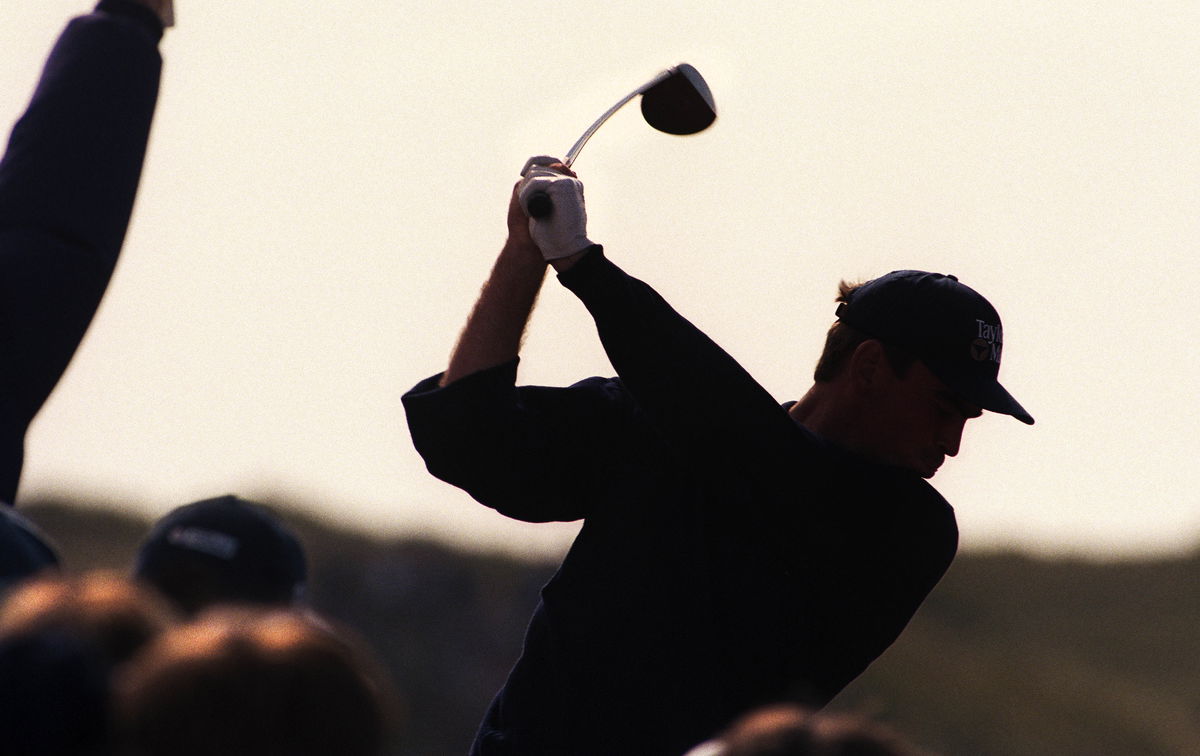
Getty
Silhouetted golfer on the tee during the 127th British Open Golf at Royal Birkdale GC in Southport 16th-19th July 1998. (Photo by David Ashdown/Getty Images)

Getty
Silhouetted golfer on the tee during the 127th British Open Golf at Royal Birkdale GC in Southport 16th-19th July 1998. (Photo by David Ashdown/Getty Images)
Most golfers freeze when they see their ball sitting in mud. They assume it’s an automatic disaster. But here’s the truth: muddy lies are manageable challenges, not unplayable nightmares. The right adjustments transform these feared shots into routine up-and-downs.
Watch What’s Trending Now!
The key is understanding what makes muddy conditions different. Soft ground causes your club to dig rather than glide. Water reduces the friction between the clubface and the ball. Sticky turf grabs your wedge during the swing.
Research from the Journal of Quantitative Analysis in Sports reveals that wet-bulb temperature accounts for 46.2% of the variance in golf scores during wet conditions. That’s significant. However, tour professionals maintain scramble rates of 65-70% in wet conditions versus 60-65% in dry conditions by making proper technique adjustments.
ADVERTISEMENT
The 2025 PGA Championship at Quail Hollow highlighted just how challenging these conditions can be. Scottie Scheffler expressed frustration after his round.
“I don’t think you should get punished for hitting the ball in the middle of the fairway. There’s enough luck throughout a 72-hole tournament that I don’t think the story should be whether or not the ball is played up or down.”
Both Scheffler and Xander Schauffele made double bogeys from fairway lies due to unpredictable mud ball flight. The controversy even sparked debate about preferred lies rules. Yet mastering proper technique from muddy lies eliminates much of this unpredictability.
ADVERTISEMENT
Top Stories
Top 3 PGA Tour Pros Who Missed Their Card After RSM Classic

Tour Pro Hit With Brutal 5-Month Punishment Only 11 Days After Celebrating Career Feat

Jordan Spieth Set to Pay a Heavy Price for Unexplained PGA Tour Absence

Jack Nicklaus’ Former Company Announces Bankruptcy After $50M Lawsuit Defeat

Support Pours in as PGA Tour Pro Bursts Into Tears Over Strict New Policy

1. Master Your Setup for Muddy Lie Ball-First Contact
Ball position dictates everything in muddy conditions. Place the ball just back of center in your stance. Position your chest bone several inches ahead of the ball. This setup dictates where your swing bottoms out.
ADVERTISEMENT
Dan Grieve, head professional at Woburn Golf Club, emphasizes this fundamental: “If we get the setup right, like all lies, it becomes a lot easier.”
View this post on Instagram
Keep your shoulders level. Avoid tipping your right shoulder down. That mistake moves your low point behind the ball. Weight distribution matters equally. Shift approximately 60-70% of your weight onto your lead foot. This promotes a downward strike into the back of the ball while preventing early ground contact.
ADVERTISEMENT
Narrow your stance slightly. This creates more control and prevents swaying on unstable turf.
2. Choose Leading Edge Over Bounce for Wet Conditions
Here’s where muddy lies break conventional wisdom. Bounce is typically your friend in short game situations. Not here, though. Grieve explains the paradox clearly.
ADVERTISEMENT
“You’ve seen some of the other videos, we talked a lot about the bounce and how the bounce is really your friend. And for almost all short game shots, that’s the case. Apart from this one, where it really becomes your foe.”
Use more of the sharp leading edge to contact the back of the ball. When the bounce engages with soft mud, the club just digs in. The ball goes nowhere. Consider raising your hands slightly at the address. This reduces heel digging and promotes cleaner leading-edge contact.
For club selection, use wedges with lower to moderate bounce angles (6-10°) in sticky mud. Save higher bounce options (12-14°) for clean wet grass lies only.
3. Simplify Your Muddy Lie Swing Technique
Wet conditions punish complicated motions. Use a tight, compact swing instead. Keep your wrists firm during the takeaway and through impact. Excessive wrist hinge creates inconsistent contact when the club meets unpredictable resistance.
Carlo Ciullo emphasizes proper motion through impact: “Mentally when golfers start sitting on these wet lies and the balls down on these soft lies, the golfer starts to drive the handle down. And that’s what we don’t want because you start driving the hands down too steeply.”
Focus on extension upward and through instead. Control the shot with body rotation rather than arm manipulation. Turn through with your core while maintaining a stable hand position. This provides more consistent contact and prevents the club from stalling in soft ground.
Most importantly, accelerate through the shot. Deceleration causes fat contact. Commit to a smooth, confident stroke even when conditions look sketchy.
4. Read Your Muddy Lie Before Shot Selection
Not all wet lies are equal. A clean ball on damp grass plays differently from a ball buried in mud. Assess carefully before choosing your approach.
For clean wet lies sitting up, your standard chip with minor modifications works fine. When the ball sits down in mud, treat it like a basic chip shot. Hands forward, minimal wrist action, low follow-through. A lower-lofted club or wedge with less bounce prevents sticking.
Thick wet grass behind the ball requires a firmer, descending blow. Avoid flop shots here. The thick grass will twist your face or cause chunks. For tight, soggy lies with minimal grass underneath, play a bump-and-run with a pitching wedge or 9-iron. Get the ball rolling quickly rather than trying for perfect contact.
5. Build Muddy Lie Confidence Through Deliberate Practice
Most golfers avoid practicing in wet conditions. That’s precisely when valuable experience develops. Head to the practice green after the rain. Hit chips from various wet lies. Create mini wet-lie drills by pouring water on practice areas.
Callum Beveridge offers accessible advice for building this skill: “Narrow stance, weight slightly left, toe-down club position, and minimal wrist hinge.”
This simplified approach makes the technique more accessible for amateur golfers.
Use a wet-weather glove on soggy days. Keep two towels in your bag for rotating between clubs and hands. Stay mentally steady by accepting that wet lies increase unpredictability. Approach each one as a problem to solve rather than a disaster to fear.
Grieve’s philosophy applies perfectly here: “There is no such thing as a bad lie, all you need to learn is how to adapt to the situation at hand to give yourself the best chance of making a good strike.”
With proper setup, smart club selection, simplified technique, lie-based shot selection, and committed execution, muddy lies transform from feared situations into manageable challenges. What once felt like disaster shots becomes just another opportunity to save par.
ADVERTISEMENT
ADVERTISEMENT
ADVERTISEMENT

